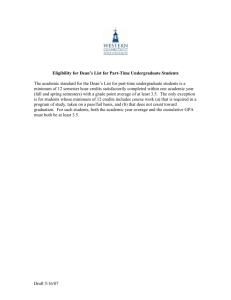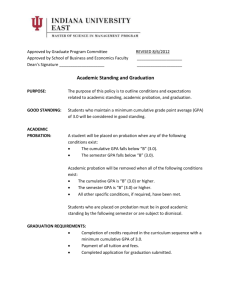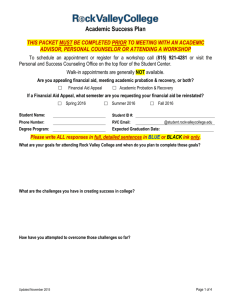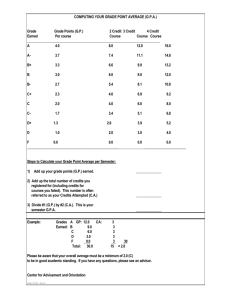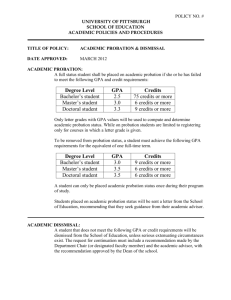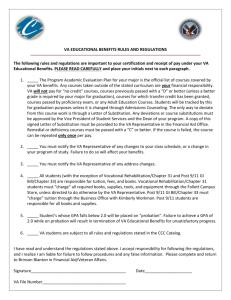Early Alert Probationary Advising (PPT)
advertisement
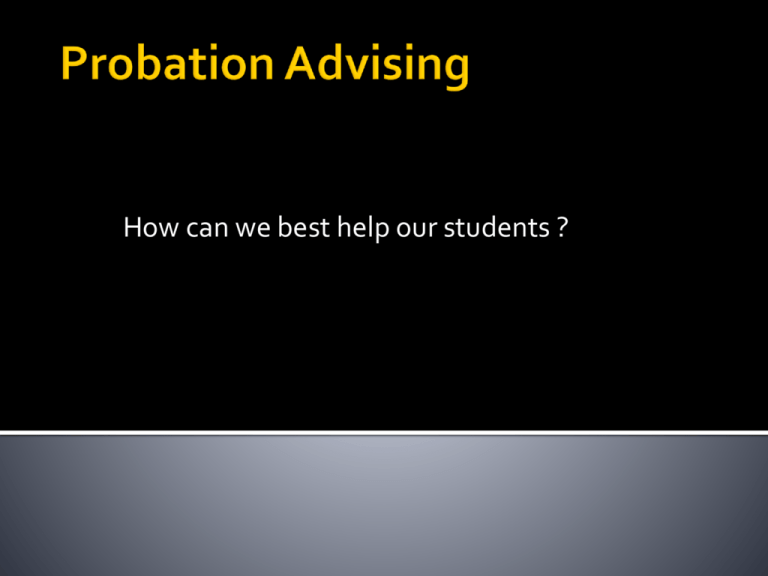
How can we best help our students ? Academic Probation is earned and the notation "Academic Probation" is recorded on the student's academic transcript. Students on Academic Probation are required to develop an academic success agreement in consultation with their Academic Advisor. Academic Watch— Full-time student has a cumulative GPA or 2.0 or higher but GPA falls below 2.0 in one semester or term. Students in this category are limited to 4 courses and must meet with Academic Support Services. Academic Warning—Part-time student with a cumulative GPA below 2.0 after 6 credits. Students in this category will be place on academic probation after 9 credits if the GPA does not improve. Academic Probation ( transcript notations: “Probation 1” and “Probation 2”)—Full or Part-time student with a cumulative GPA below 2.0 (or 1.75 for first year students). Also, a full or part-time student who has completed less than 2/3 of attempted credits-attempted credits include: F, NP, I, WP, WF or W. Academic Probation Actions - Full time students in this category are limited to 4 courses. Part-time students in this category are limited to 2 courses. Students in this category cannot participate in athletics or inter-collegiate activities. Students in this category must meet with a representative from Academic Support Services. Students who remain on probation for two consecutive semesters will face academic dismissal the following semester. Probation ends when the cumulative GPA reaches 2.0. In order to make Satisfactory Academic Progress a student must maintain a cumulative GPA of 2.0 or higher (1.75 for first year students) and complete 2/3 of all attempted credits. In addition, students must complete credits according to a schedule not to exceed 150% of credits necessary for degree. Question: Does this mean that students cannot take more than 64 credits in excess of a BA degree? Answer: Financial Aid will not cover credits over this limit. Financial Aid reviews students academic records periodically, typically in Fall, Spring and Summer semesters for full time students and after every 9 credits for part-time students. If students are not making satisfactory academic progress, they are not eligible for aid the following semester. It is important to note that summer functions as a “make-up” term. Students who are not making satisfactory academic progress during the regular academic year may enroll during the summer term to regain SAP. Question: Is this about numbers—meaning the student needs to raise cumulative GPA and/or complete 2/3 of her credits — OR is this about a good faith effort meaning that a student who does well in the summer is allowed to receive aid for the fall regardless of cumulative GPA? Answer: This is about numbers: GPA above 2.0 or completion of attempted credits towards degree. Students can appeal. If the appeal is not approved, financial aid will not be restored until student begins to make satisfactory academic progress. After aid is withdrawn, many students choose to take courses at a local community college to regain SAP. Explain the impact of unsatisfactory academic progress on financial aid. Many students are not aware of the relationship between GPA, courses completed and financial aid. Advise students to repeat failed courses. Repeat Policy: While transcripts show every class attempted every semester, only the most favorable grade figures into the GPA. The most efficient way to raise a low GPA is to repeat failed courses. (Question: Does the repeated course still figure in the attempted/completed ratio?). Advise Students to contact Academic Support Services. Academic Support is available in the library. Depending on their probation status, students may be required to contact academic support. (Dr. Kimberly LaBoone) Triage Program: Recommend that students contact Academic Advising via the Triage link (http://www.trinitydc.edu/casadvising/triage-program/#form) Submit early alert notices. Early Alert forms are due (insert date). These forms help to identify students who need academic support while there is still enough time to make a real difference. Make failing students aware of withdrawal deadlines. The withdrawal deadline for this semester is (insert date). While withdrawals do count against the attempted/completed ratio, withdrawal is better than earning an F in most cases. Post midterm grades. Midterm grades function as a “wake-up call” for students and teachers alike. Calculating midterm grades helps you to identify students who are doing poorly and gives student a realistic idea of their grade in your course. Midterms also help with withdraw decisions. You can submit an early alert any time (paper form or electronic form) Midterm is Oct. 3rd – 8th (Midterm grades due Oct. 12th) Spring registration begins Oct. 31st The last day to withdraw is Nov. 11th Do you have any questions about the information presented today? Do you need clarification on any of the topics? Do you have any students you have concerns about? (please see us afterwards or send us an email)
